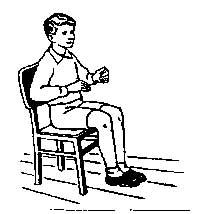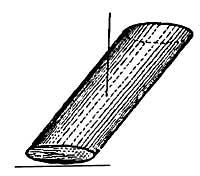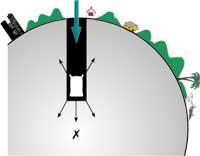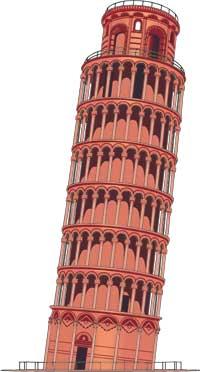Gravity and weight
1999/09/01 Bandres Unanue, Luis Iturria: Elhuyar aldizkaria
Haika boy, gets up…

If we were to say to anyone, "Sit in that chair and you won't be able to get up without any ties," I would think we're very concerned. But let's do the test. As it appears in the image, we will sit down, that is, with the body upright and without the legs entering under the chair. Let's try to get up without changing the position of the legs and keeping the body upright (without pulling it forward). After a thousand attempts and despite using the strength of all our muscles, we will not get up from the chair if we have not placed the legs under the chair or have not tilted the body forward.

To
understand why all this happens, we must worry about the balance of all bodies in general and of humanity in particular. To prevent any object in a vertical position from falling or turning, the vertical that passes through its center of gravity must pass through the inside of the base of the object. Therefore, the inclined cylinder shown in the image would be naturally detached. But if this cylinder were wider and the vertical that passes through the center of gravity did not go out by the limit of the base, the cylinder would not return. Therefore, the tower of Pisa, although inclined, stands because the vertical that passes through its center of gravity passes through the inside of its base (the other reason, but the second, is the depth of the buried foundations).
The standing person will not fall when the vertical of its center of gravity passes through the interior of the surface delimited by the outer edges of the plants. That is why it is so difficult to stand on one foot and even more difficult to keep balance on the wire. As the base is so small, the vertical of the center of gravity immediately leaves the surface boundary. Have you noticed how old sailors are walking? As his whole life moves in the sea and the floor of the boat swings, the vertical of his center of gravity would easily leave the enclosure delimited by the feet, and for this not to happen, for that base to be as large as possible, move in this very peculiar way, carrying his feet very open. When they are at the back of the boat they get the stability they need while the pavement moves, but when they go down to land they continue with the habit of dizzying, that is, with that eccentric march.

You can
also set a reverse example. That is the case for those who have an elegant career for their work. Today we do not see that among us, but until recently in Euskal Herria, as in other places, to transport certain loads (milk in marmites, vegetables in a large basket, etc.) women used to carry a load on the head. In order to carry these loads on the head, it was necessary to have the head and body totally erect, since the slightest dive came out of the base of the body the vertical of the center of gravity (which in these cases was higher than normal) and the balance of loads would be lost. Through their custom, these women had a slender and elegant march.
Let us go back to the companion we have left sitting. The center of gravity of the sitting person is located inside his body, next to the column and about twenty centimeters above the navel. The vertical that passes under this point passes behind the plants and for the person to rise has to go through the environment that delimit the aforementioned plants. Therefore, in order to get up you will have to tilt the body forward and thus carry forward the center of gravity. Thus, when the point of support is in the vertical of the center of gravity it will be able to rise with force.
Maximum body weight

As
we all know, the Earth exerts a tractor force on the bodies around it, which we call "weight." On the other hand, this force is smaller as we move the body away from the Earth's surface. If we carried a weight of one kilo at a height of 6,400 km, that is, at a distance from the center of the Earth of twice its radius, the force of attraction would be 22, that is, four times less, and if we measured the "weight" of that same weight through the dynamometer that we calibrated on the surface of the Earth, instead of having a kilo, we would have 250 g. According to the law of universal gravitation, the Earth Sphere attracts the bodies around it as if all its mass were concentrated in the center, and, on the other hand, that force is inversely proportional to the square of the distance. Therefore, since the distance of the body has been double that of the center of the Earth, the force of attraction has been 22, that is, four times smaller. Likewise, if we moved the body to 12,800 km from the earth's surface, the distance to the center of the Earth would be three times greater and the force 32, that is, nine times less. The meter would now mark a "weight" of 111 g. The first conclusion is that as we weigh higher, lighter.
But with the same logic, the reading that the dynamometer would give should be growing. But that is not so. The bodies inside the Earth are smaller than the larger "weights." To understand it, just look at the image.
In this case the fractions of Earth are not all beside the body, as before (below). Now some are under and some are over, and each pulls to his side. Therefore, the body will endure descending and ascending forces. Finally, all these forces join together and, consequently, the force exerted on the body is equal to the resulting radius sphere from its position to the center of the Earth (which can be demonstrated). Therefore, when we carry the body into the Earth, it loses "weight". If we took him to the center of the Earth, he would lose all his "weight", for in this case all the parts of the Earth around would throw the same force in all directions.
Therefore, the bodies have their greatest weight on the surface of the Earth and away from it, both above and below, the "weight"
is less. So if you're a little fat you already know what to do: weigh on the plane or at the bottom of the deep mine, at least you'll stay a little.

Gai honi buruzko eduki gehiago
Elhuyarrek garatutako teknologia





